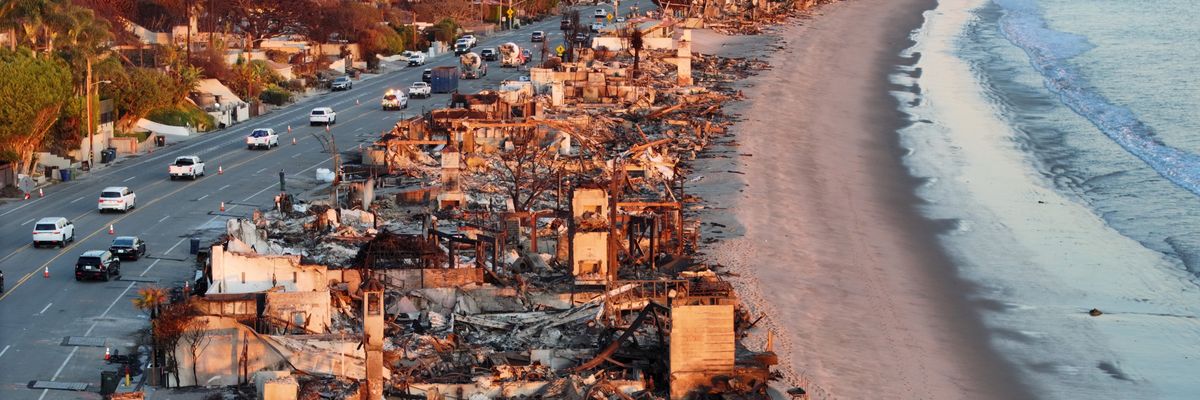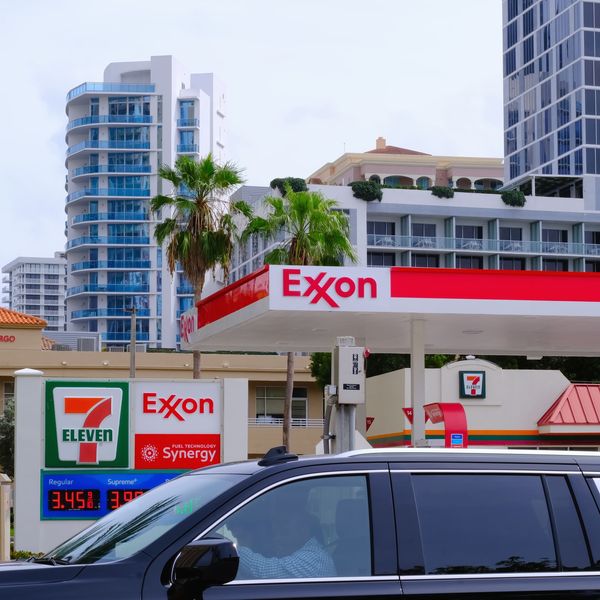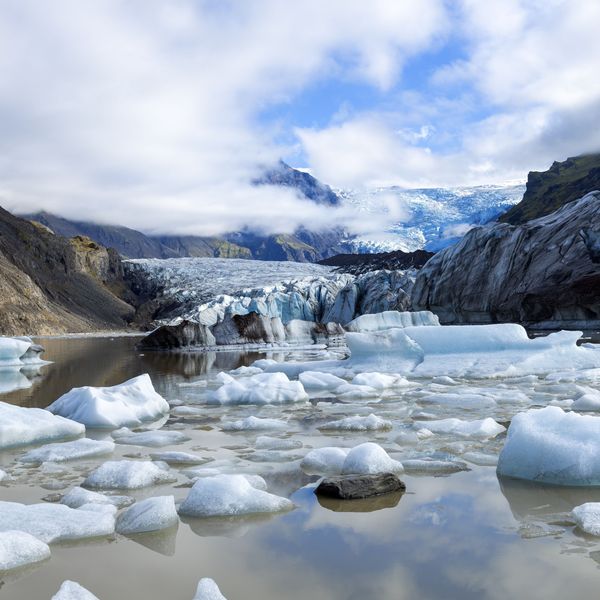
An aerial view of repair vehicles at sunset passing near beachfront homes that burned in the Palisades Fire on January 15, 2025 in Malibu, California.
Critics Warn Media Outlets Failing to Explain Climate Cause Behind Los Angeles Fires
"Too much of the coverage has simply ignored the climate crisis altogether, an inexcusable failure when the scientific link between such megafires and a hotter, dryer planet is unequivocal," wrote the founders of Covering Climate Now.
Covering the who, what, when, where, and why is journalism 101. So why are too few media outlets explaining the role that the climate crisis plays in the "why" behind the fires ravaging the Los Angeles region?
That's the central question posed in an opinion piece published in The Guardian and elsewhere on Thursday authored by Mark Hertsgaard and Kyle Pope, the founders of Covering Climate Now, a global collaboration of over 500 news outlets aimed at improving climate coverage, of which Common Dreams is a part.
Hertsgaard and Pope wrote that "too much of the coverage has simply ignored the climate crisis altogether, an inexcusable failure when the scientific link between such megafires and a hotter, dryer planet is unequivocal."
They added: "Too many stories have framed the fires as a political spat between U.S. President-elect Donald Trump and California elected officials instead of a horrifying preview of what lies ahead if humans don't rapidly phase out fossil fuels. Too often, bad-faith disinformation has been repeated instead of debunked."
Misinformation, in many instances stemming from right-leaning sources, have proliferated since the blazes broke out last week. Trump in a social media post appeared to point the finger at California's statewide water management plans for fire hydrants running dry as firefighters fought the blazes last week. Southern California does have plenty water stored, but the city's infrastructure was not designed to respond to a fire as the large as the ones that broke out, experts told PBS. Another user on the platform X falsely claimed that California turned away fire trucks from Oregon because of their emission levels, according to KQED.
Hertsgaard and Pope also called for outlets to name names. "Rarely have stories named the ultimate authors of this disaster: ExxonMobil, Chevron, and other fossil fuel companies that have made gargantuan amounts of money even as they knowingly lied about their products dangerously overheating the planet," they wrote.
While the fires are still burning, researchers are already drawing the links between climate change and the blazes. In a thread on Bluesky, the climate scientist Daniel Swain explained the concept of climate "hydroclimate whiplash"—which southern California experienced in 2024—and how this can create ideal conditions for fires to spread.
The authors of the opinion piece noted that there have been bright spots when it comes to covering the fires with an eye toward the climate emergency and debunking false and misleading claims about the fires. The duo highlight a Time story that is titled "The LA fires show the reality of living in a world with 1.5C of warming" and a column written by the Los Angeles Times' Sammy Roth, which began: "Los Angeles is burning. Fossil fuel companies laid the kindling."
Hertsgaard and Pope wrote, "When a house is on fire, by all means let journalism show us the flames."
"But tell us why the house is burning, too," they added.
An Urgent Message From Our Co-Founder
Dear Common Dreams reader, The U.S. is on a fast track to authoritarianism like nothing I've ever seen. Meanwhile, corporate news outlets are utterly capitulating to Trump, twisting their coverage to avoid drawing his ire while lining up to stuff cash in his pockets. That's why I believe that Common Dreams is doing the best and most consequential reporting that we've ever done. Our small but mighty team is a progressive reporting powerhouse, covering the news every day that the corporate media never will. Our mission has always been simple: To inform. To inspire. And to ignite change for the common good. Now here's the key piece that I want all our readers to understand: None of this would be possible without your financial support. That's not just some fundraising cliche. It's the absolute and literal truth. We don't accept corporate advertising and never will. We don't have a paywall because we don't think people should be blocked from critical news based on their ability to pay. Everything we do is funded by the donations of readers like you. Will you donate now to help power the nonprofit, independent reporting of Common Dreams? Thank you for being a vital member of our community. Together, we can keep independent journalism alive when it’s needed most. - Craig Brown, Co-founder |
Covering the who, what, when, where, and why is journalism 101. So why are too few media outlets explaining the role that the climate crisis plays in the "why" behind the fires ravaging the Los Angeles region?
That's the central question posed in an opinion piece published in The Guardian and elsewhere on Thursday authored by Mark Hertsgaard and Kyle Pope, the founders of Covering Climate Now, a global collaboration of over 500 news outlets aimed at improving climate coverage, of which Common Dreams is a part.
Hertsgaard and Pope wrote that "too much of the coverage has simply ignored the climate crisis altogether, an inexcusable failure when the scientific link between such megafires and a hotter, dryer planet is unequivocal."
They added: "Too many stories have framed the fires as a political spat between U.S. President-elect Donald Trump and California elected officials instead of a horrifying preview of what lies ahead if humans don't rapidly phase out fossil fuels. Too often, bad-faith disinformation has been repeated instead of debunked."
Misinformation, in many instances stemming from right-leaning sources, have proliferated since the blazes broke out last week. Trump in a social media post appeared to point the finger at California's statewide water management plans for fire hydrants running dry as firefighters fought the blazes last week. Southern California does have plenty water stored, but the city's infrastructure was not designed to respond to a fire as the large as the ones that broke out, experts told PBS. Another user on the platform X falsely claimed that California turned away fire trucks from Oregon because of their emission levels, according to KQED.
Hertsgaard and Pope also called for outlets to name names. "Rarely have stories named the ultimate authors of this disaster: ExxonMobil, Chevron, and other fossil fuel companies that have made gargantuan amounts of money even as they knowingly lied about their products dangerously overheating the planet," they wrote.
While the fires are still burning, researchers are already drawing the links between climate change and the blazes. In a thread on Bluesky, the climate scientist Daniel Swain explained the concept of climate "hydroclimate whiplash"—which southern California experienced in 2024—and how this can create ideal conditions for fires to spread.
The authors of the opinion piece noted that there have been bright spots when it comes to covering the fires with an eye toward the climate emergency and debunking false and misleading claims about the fires. The duo highlight a Time story that is titled "The LA fires show the reality of living in a world with 1.5C of warming" and a column written by the Los Angeles Times' Sammy Roth, which began: "Los Angeles is burning. Fossil fuel companies laid the kindling."
Hertsgaard and Pope wrote, "When a house is on fire, by all means let journalism show us the flames."
"But tell us why the house is burning, too," they added.
Covering the who, what, when, where, and why is journalism 101. So why are too few media outlets explaining the role that the climate crisis plays in the "why" behind the fires ravaging the Los Angeles region?
That's the central question posed in an opinion piece published in The Guardian and elsewhere on Thursday authored by Mark Hertsgaard and Kyle Pope, the founders of Covering Climate Now, a global collaboration of over 500 news outlets aimed at improving climate coverage, of which Common Dreams is a part.
Hertsgaard and Pope wrote that "too much of the coverage has simply ignored the climate crisis altogether, an inexcusable failure when the scientific link between such megafires and a hotter, dryer planet is unequivocal."
They added: "Too many stories have framed the fires as a political spat between U.S. President-elect Donald Trump and California elected officials instead of a horrifying preview of what lies ahead if humans don't rapidly phase out fossil fuels. Too often, bad-faith disinformation has been repeated instead of debunked."
Misinformation, in many instances stemming from right-leaning sources, have proliferated since the blazes broke out last week. Trump in a social media post appeared to point the finger at California's statewide water management plans for fire hydrants running dry as firefighters fought the blazes last week. Southern California does have plenty water stored, but the city's infrastructure was not designed to respond to a fire as the large as the ones that broke out, experts told PBS. Another user on the platform X falsely claimed that California turned away fire trucks from Oregon because of their emission levels, according to KQED.
Hertsgaard and Pope also called for outlets to name names. "Rarely have stories named the ultimate authors of this disaster: ExxonMobil, Chevron, and other fossil fuel companies that have made gargantuan amounts of money even as they knowingly lied about their products dangerously overheating the planet," they wrote.
While the fires are still burning, researchers are already drawing the links between climate change and the blazes. In a thread on Bluesky, the climate scientist Daniel Swain explained the concept of climate "hydroclimate whiplash"—which southern California experienced in 2024—and how this can create ideal conditions for fires to spread.
The authors of the opinion piece noted that there have been bright spots when it comes to covering the fires with an eye toward the climate emergency and debunking false and misleading claims about the fires. The duo highlight a Time story that is titled "The LA fires show the reality of living in a world with 1.5C of warming" and a column written by the Los Angeles Times' Sammy Roth, which began: "Los Angeles is burning. Fossil fuel companies laid the kindling."
Hertsgaard and Pope wrote, "When a house is on fire, by all means let journalism show us the flames."
"But tell us why the house is burning, too," they added.

